Wireless electric car charging

Electric car wireless parking charge closeup, fot. Autor NJo (Praca własna) [CC BY-SA 3.0
The widespread use of electric vehicles (EVs) could make a tremendous contribution to the reduction of urban pollution and global carbon dioxide emissions. Novel wireless charging technology with increased convenience and providing longer driving distances may tip the scales.
In the last decade, most major automobile manufacturers have invested in research and development of EV technologies. Excellent progress has been made and EVs are now a small part of the landscape of many countries and their roadways. However, important technical obstacles associated with faster charging the EVs must be overcome to increase market uptake.
Exploitation of a phenomenon discovered in the early 1800s, the principle of electromagnetic induction, may provide the answer in the form of wireless charging. Scientists working on the EU-funded project 'Innovative fast inductive charging solution for electric vehicles' (FASTINCHARGE) are creating the electricity for charging by exposing a coil (a wound conductor) to a varying magnetic field. The result is EV charging with no need to plug in. The technology is targeted to enable a 40 kW power transfer to EVs in either stationary or en route situations.
Currently, EV owners have several options for recharging their cars, depending on where they live. The most common is still to charge overnight (stationary) at home. There are also public charging stations for charging while parked at shops and businesses, as well as high-power, fast-charge stations similar to conventional gas stations.
FASTINCHARGE is developing the fast inductive charging technology that will be implemented in one EV, one charging station of four blocks installed at an urban crossroad and one stationary charging station. The team is assessing all necessary components, including EV performance and safety, EV range, grid connection and management, and intelligent coordinated systems.
Within the first project phase, the team produced prototypes for the stationary and mobile applications as well as the test bench on which to assess performance of the technology. Scientists also conducted an analysis of user acceptance of various EV inductive charging solutions.
Researchers plan to demonstrate the enhanced convenience of the new technology. Its simplicity with no plug-in and reduced charging time combined with increased driving range by charging on the road when stopped at the electrified crossroad should foster enthusiasm on the part of potential EV customers. Reduced total cost of ownership compared to previous solutions could tip the scale and make the sale.
published: 2015-04-22